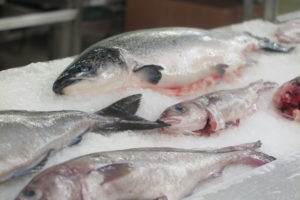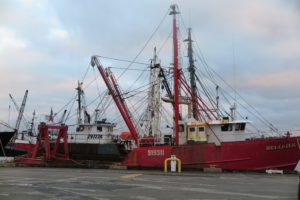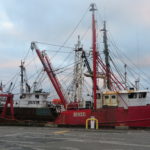School of Fish
A Journey to the
Northern Atlantic Coast
Fishing Industry
Baked Haddock with Fresh Lemon Juice
Poached Lemon Sole Picatta
Pan Seared Hake with Herbed Butter
Broiled Acadian Redfish with Cilantro Lime Butter
Class begins at 6:00 am sharp in Boston. The rain is pouring down as we walk from our hotel parking lot to the Foley Fish Plant next door where things are already bustling. Fish is being sold, fish is being bought, fish is being processed. This is the start of a two day adventure taking us from boat to auction, auction to processing plant, processing plant to shipment. Myself and twelve other food professionals have been invited by one of the oldest most reputable fish companies in the country to view their process and to teach us about fish quality, preservation, management and sustainability.
Foley Fish boasts the highest fish standards in the country. It starts with the quality of fish bought at auction. It is extended
Similar to my experience in Washington visiting the Double R Ranch, the experience of learning first hand where your food is coming from is so eye opening. We forget, as we gaze at the beautiful fish fillets in the display case, that a lot of people are involved that are very passionate about the quality of fish they are catching, processing and packaging. Their goal is to bring to the consumer the finest and freshest fish available.
A common question we get at the fish counter is “When did the fish arrive?” That is a very important question but the even more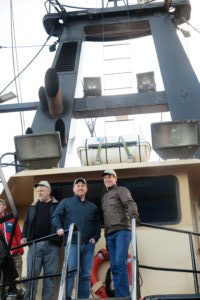 important question is “When was the fish caught?” And followed up by that, “How was the fish maintained between when it was caught and when you ate or purchased it?” Fishing vessels can be out at sea for one to eight days at a time. The fish is stored surrounded in ice in the hull of the ship. The cost of the fish varies depending on when it was caught. The last day or two of catches are obviously more expensive. So like many things, the price does directly relate to the quality when it comes to fish. Most wholesalers purchase fish at the dock, sell it after they purchase it and then use a distributor to get it to the restaurant or retailer. Foley’s buys only what it sold that morning and only buys the freshest catches. Then they ship it directly to their customers. They have four buyers at four auctions (Portland, Boston, New Bedford and the West Coast). They’re at the auctions by 4:30 am, with the day’s orders in hand.
important question is “When was the fish caught?” And followed up by that, “How was the fish maintained between when it was caught and when you ate or purchased it?” Fishing vessels can be out at sea for one to eight days at a time. The fish is stored surrounded in ice in the hull of the ship. The cost of the fish varies depending on when it was caught. The last day or two of catches are obviously more expensive. So like many things, the price does directly relate to the quality when it comes to fish. Most wholesalers purchase fish at the dock, sell it after they purchase it and then use a distributor to get it to the restaurant or retailer. Foley’s buys only what it sold that morning and only buys the freshest catches. Then they ship it directly to their customers. They have four buyers at four auctions (Portland, Boston, New Bedford and the West Coast). They’re at the auctions by 4:30 am, with the day’s orders in hand.
In class we were taught how to visually grade the fish. How to tell how old the fish was, had it been injected, had it been properly stored. Given samples of various fish with various degrees of quality, we learned to use the five sensory test to evaluate the fish: Smell, Touch, Eye, Taste and Temperature.
The following morning we were boarding our van at 4:30 am headed to the Whaling City Fish Display Auction in New Bedford.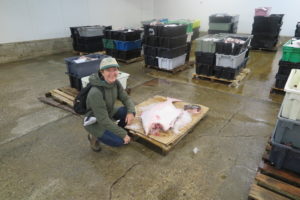
Now it’s up to me to maintain that fish for you. It arrives iced. We then inspect every fillet, re ice it and place it in coolers inside our walk in cooler. The display case is maintained at 32 degrees (just above freezing), keeping the fish at the optimal temperature for freshness. Now it’s your turn and you’re taking it home. To keep that perfect temperature going, place it in the back of refrigerator on ice. You can’t get any fresher than that!
I learned so much I could just go on and on. I’ll have to share more in another article. But, the one thing I did want to share with